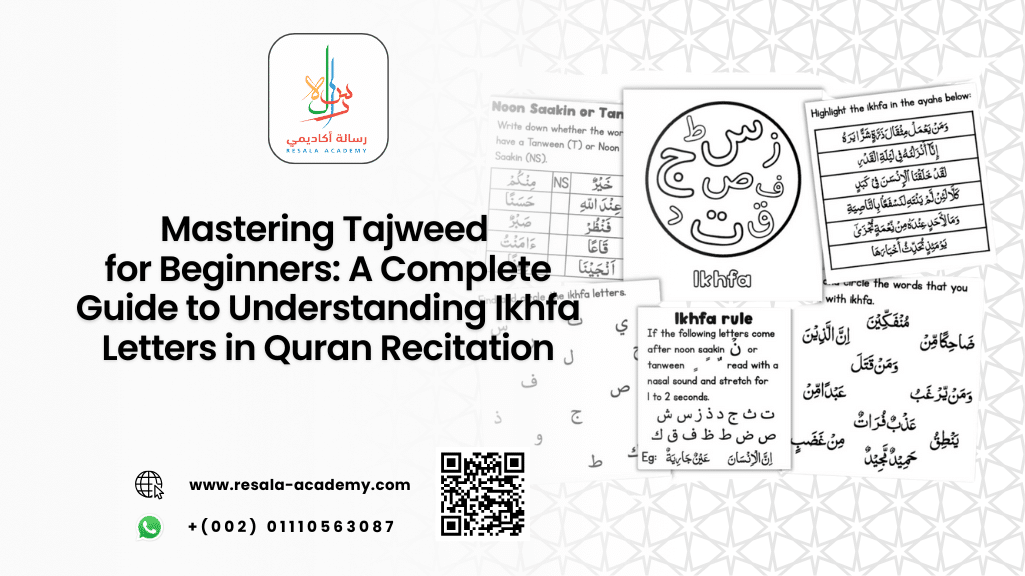Table of Contents
Mastering Tajweed for Beginners: A Complete Guide to Understanding Ikhfa Letters in Quran Recitation
Learning to recite the Quran correctly is a spiritual journey that brings one closer to the words of Allah ﷻ. One of the most essential aspects of this journey is mastering the science of Tajweed.
The set of rules governing pronunciation during Quranic recitation. Among these rules, understanding the concept of Ikhfa Letters is crucial for beginners aiming to recite the Quran with precision and beauty.
In this comprehensive guide, we will explore the fundamentals of Ikhfa, its importance in Tajweed, and how non-native Arabic speakers can master it effectively. We’ll also highlight how Resala Academy serves as a leading platform for learning Quranic Arabic and Tajweed online.
What Is Tajweed and Why Is It Important?
Tajweed (تجويد) literally means “to make better” or “to improve.” In the context of Quranic recitation, it refers to the set of phonetic rules that govern how each letter should be pronounced when reading the Quran.
The Purpose of Tajweed
- Preserving the original pronunciation of the Quran as revealed to the Prophet Muhammad ﷺ.
- Avoiding mispronunciations that could alter the meanings of verses.
- Enhancing the spiritual experience of recitation.
The Prophet ﷺ said:
“ مَنْ قَرَأَ حَرْفًا مِنْ كِتَابِ اللَّهِ فَلَهُ بِهِ حَسَنَةٌ وَالْحَسَنَةُ بِعَشْرِ أَمْثَالِهَا”
“Whoever recites a letter from the Book of Allah will receive one good deed as ten good deeds like it.”
— Jami` at-Tirmidhi 2910
Introduction to Ikhfa in Tajweed
The word Ikhfa (الإخفاء) in Arabic means “to hide” or “to conceal.” In Tajweed, it refers to the rule applied when a noon sakinah (نْ) or tanween (ً ٍ ٌ) is followed by one of the 15 specific letters known as the Ikhfa Letters.
Instead of pronouncing the noon sound clearly (as in Idhar) or merging it completely (as in Idgham), the sound is partially hidden and accompanied by a nasal sound (ghunnah).
Understanding the Ikhfa Letters
There are 15 letters in the Arabic alphabet that trigger the Ikhfa rule. These are:
ت – ث – ج – د – ذ – ز – س – ش – ص – ض – ط – ظ – ف – ق – ك
How to Identify Ikhfa
Ikhfa occurs when:
- A noon sakinah (نْ) or tanween appears, and
- It is followed by any of the above Ikhfa Letters.
Examples from the Quran
- Surah Al-Baqarah (2:2)
Arabic:ذَٰلِكَ ٱلۡكِتَٰبُ لَا رَيۡبَۛ فِيهِۛ هُدٗى لِّلۡمُتَّقِينَ
Transliteration:
Hudan lil-muttaqīn
Explanation: The tanween on “هُدٗى” is followed by the letter “ل” (lam), which is not an Ikhfa letter, so no Ikhfa here.
- Surah Al-Insan (76:2)
Arabic:إِنَّا خَلَقْنَا ٱلْإِنسَٰنَ مِن نُّطْفَةٍ
Transliteration:
Min nutfah
Explanation: The noon sakinah in “مِن” is followed by the letter “ن” (noon), which triggers Idgham, not Ikhfa.
- Surah Al-Fajr (89:21)
Arabic:كَلَّآ إِذَا دُكَّتِ ٱلۡأَرۡضُ دَكّٗا دَكّٗا
Here, the tanween is followed by a dal (د), which is an Ikhfa letter. Hence, the noon sound is hidden with a nasal tone.
Advanced Nuances of Ikhfa Letters: Phonetic Depth and Articulation Mastery
Understanding the Ikhfa Letters at a surface level is essential for beginners, but to truly excel in Tajweed, learners must delve into the phonetic subtleties that differentiate each letter’s interaction with the noon sakinah or tanween.
Each of the 15 letters in the Ikhfa category produces a slightly different degree of concealment based on its makhraj (articulation point) and sifat (characteristics). This advanced understanding is particularly beneficial for non-native speakers aiming for precise Quranic recitation.
- Categorization by Proximity: The degree of Ikhfa varies depending on how close the following letter is to the articulation point of noon. Scholars divide the Ikhfa Letters into three phonetic proximity levels:
- Close Proximity (e.g., ت, د, ط): These letters are articulated near the tongue’s tip, producing a stronger nasalization.
- Medium Proximity (e.g., ج, ش, ق): These require a balanced nasal tone with moderate concealment.
- Distant Proximity (e.g., ك, ق): These demand a lighter nasal sound due to their articulation at the back of the mouth.
- Impact of Letter Characteristics: Letters with strong qalqalah (echoing) traits like ق and ط require careful modulation during Ikhfa to avoid overemphasis or distortion of the nasal sound.
- Tajweed Science Integration: Advanced learners benefit from studying how Ikhfa interacts with other Tajweed rules such as ghunnah, madd, and waqf. For example, applying Ikhfa at the end of a verse (waqf) requires maintaining the nasalization without extending it unnaturally.
- Auditory Training Techniques: Students are encouraged to use spectrogram analysis tools or Tajweed apps that visually display nasalization intensity, helping learners fine-tune their pronunciation of Ikhfa Letters with scientific accuracy.
- Teacher-Guided Drills: At Resala Academy, instructors employ phonetic drills that isolate each Ikhfa Letter in various Quranic contexts, enabling students to master subtle articulation differences through repetition and correction.
Contextual Application of Ikhfa in Quranic Themes and Surahs
Beyond technical mastery, understanding the contextual use of Ikhfa Letters in the Quran enhances both comprehension and spiritual connection.
Many verses that employ Ikhfa are thematically rich, and their phonetic beauty reinforces the emotional and rhetorical power of the message.
Thematic Reinforcement Through Sound:
- Ikhfa Letters often appear in verses discussing divine justice, repentance, or warnings, where the concealed sound adds a layer of linguistic subtlety that mirrors the hidden nature of divine knowledge or human intentions.
- This phonetic artistry is not coincidental but a reflection of the Quran’s miraculous eloquence.
Memorization Benefits:
Students who internalize the contextual meaning of verses where Ikhfa is applied often find it easier to memorize and recall them, as the sound patterns become emotionally and cognitively anchored.
Resala Academy’s Thematic Tajweed Approach:
Courses at Resala Academy integrate thematic Tafsir with Tajweed instruction, helping learners not only apply rules like Ikhfa but also understand their spiritual and rhetorical significance within the Quranic narrative.
By exploring the advanced phonetic dynamics and contextual applications of Ikhfa Letters, learners can elevate their Tajweed proficiency from mechanical recitation to a deeply reflective and spiritually resonant experience.
The Correct Pronunciation of Ikhfa
- Identify the Noon Sakinah or Tanween: Look for the signs: نْ or ً ٍ ٌ
- Check the Following Letter: Is it one of the 15 Ikhfa Letters? If yes, apply Ikhfa.
- Apply Ghunnah (Nasalization): The sound should be held for two counts (madd).
- Do Not Pronounce the Noon Clearly: The sound is hidden and flows into the next letter with a nasal tone.
Tips for Accurate Pronunciation
- Practice with a qualified teacher from Resala Academy.
- Use audio recitations by expert Qaris to mimic the sound.
- Record your own recitation and compare it with correct examples.
Why Non-Native Speakers Struggle with Ikhfa
For learners whose first language is not Arabic, mastering the subtle nuances of Tajweed — especially Ikhfa — can be challenging due to:
- Lack of exposure to nasal sounds in their native language.
- Difficulty distinguishing between similar-sounding letters.
- Limited access to qualified Tajweed instructors.
This is where Resala Academy plays a transformative role by offering structured, interactive online courses tailored for non-native learners.
How Resala Academy Helps You Master Ikhfa
Key Features of Resala Academy’s Tajweed Courses:
📚 Structured Curriculum: Designed specifically for beginners.
👨🏫 Qualified Instructors: Native Arabic speakers with Ijazah certifications.
🕒 Flexible Timings: Learn at your own pace from anywhere in the world.
🎧 Live Sessions and Recordings: Interactive classes with playback options.
📈 Progress Tracking: Regular assessments and feedback.
Curious how long it really takes to memorize the Quran with expert guidance? Discover realistic timelines, tips, and what non-native speakers can expect—Read Now!
Student Testimonial
“Before joining Resala Academy, I struggled with Tajweed rules. Now, I can recite with confidence and understand the beauty of the Quran. Their teachers are amazing!”
— Amina, UK
Common Mistakes in Applying Ikhfa
Mistake 1: Pronouncing the Noon Clearly
This turns the rule into Idhar, which is incorrect when an Ikhfa letter follows.
Mistake 2: Skipping the Ghunnah
The nasal sound is essential and must be held for two counts.
Mistake 3: Confusing Ikhfa with Idgham
While both involve nasalization, Idgham merges the noon completely, whereas Ikhfa hides it partially.
Quranic Wisdom: Why Tajweed Matters
Allah ﷻ says in the Quran:
“Or add to it, and recite the Quran with measured recitation.”
Arabic:أَوْ زِدْ عَلَيْهِ وَرَتِّلِ ٱلۡقُرۡءَانَ تَرۡتِيلًا
This verse emphasizes the importance of Tarteel — slow, deliberate recitation with proper articulation, which is the essence of Tajweed.
Unlock Your Quranic Potential with Resala Academy
If you’ve ever felt overwhelmed by the complexities of Tajweed or struggled to pronounce Arabic letters correctly, you’re not alone. Resala Academy is here to guide you every step of the way.
With expert teachers, personalized feedback, and a curriculum designed for non-native speakers, you’ll not only understand the rules of Ikhfa — you’ll master them.
Join Resala Academy Today and transform your Quranic recitation from hesitant to harmonious.
Frequently Asked Questions (FAQs)
1. What are Ikhfa Letters in Tajweed?
Ikhfa Letters are the 15 Arabic letters that trigger the rule of Ikhfa when they follow a noon sakinah or tanween. These letters include: ت، ث، ج، د، ذ، ز، س، ش، ص، ض، ط، ظ، ف، ق، ك.
2. How can I tell if a word requires Ikhfa?
Look for a noon sakinah (نْ) or tanween followed by one of the 15 Ikhfa letters. If so, apply the nasalized, hidden pronunciation.
3. Is Ikhfa the same as Idgham?
No. While both involve nasalization, Idgham merges the noon completely into the next letter, whereas Ikhfa hides it partially with a nasal tone.
4. How long should the nasal sound (ghunnah) be held during Ikhfa?
It should be held for two counts (madd), which is approximately the time it takes to say “one-two.”
5. Can I learn Ikhfa online effectively?
Absolutely! Platforms like Resala Academy offer live classes, expert instructors, and feedback mechanisms that make online learning both effective and engaging.
Conclusion
Mastering Ikhfa Letters is a foundational step in your Tajweed journey. It enhances your recitation, deepens your connection with the Quran, and preserves the divine message as it was revealed.
For non-native speakers, the path may seem challenging, but with the right guidance, it becomes a rewarding spiritual endeavor.
Resala Academy stands as a beacon for learners worldwide, offering structured, accessible, and spiritually enriching courses in Quranic Arabic and Tajweed. Begin your journey today and let your voice echo the timeless beauty of the Quran.
Ready to take your recitation to the next level? Enroll at Resala Academy Now and start mastering Tajweed with confidence.




